Location And Access
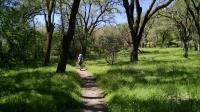
Coppertone hikes the History Trail between the pioneer cemetery and the Bale Grist Mill.
Nestled along the eastern slope of the Mayacamas Mountains, Bothe-Napa Valley State Park sits on 1,900 acres five miles north of St. Helena. The park entrance signs can be seen directly from Highway 29/128 that runs along the length of Napa Valley.
Though a state park, maintenance and administration of the park is provided by the Napa County Regional Park and Open Space District. Your state parks pass will get you into the park but be aware that the money spent on the pass does not directly benefit the group actually responsible for the day-to-day operations of this park. There is a $6.00 entrance fee to use the park (May 2017).
History
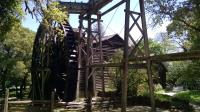
The Bale Grist Mill has been restored into full working order, including its large water wheel.
Edward Bale married into the influential Vallejo family and received a Mexican land grant of 18,000 acres in the 1841. His colorful history included a few brushes with the law but also contained a few industrious endeavours, such as the construction of his grist mill that stands to this day. Adjacent to and nearly enclosed by the park is the Bale Grist Mill State Historic Park. The mill machinery is completely operational and visitors can watch grains being ground into a fine powder and even purchase some of the output from the mill.
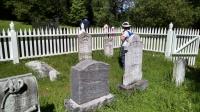
The Tucker and Kellogg families were well represented in the small pioneer cemetery.
It took some investigation into why the name "Bothe" is attached to the park. Nothing in the park's brochure mentions it. Reinhold and Jeanne Bothe owned the land that would become Napa Valley State Park and were proprietors of Paradise Park starting in 1929. The resort featured forty one cabins, a spring-fed swimming pool, stables, a lounge, tennis and bocce ball courts and a large, well-stocked bar. For some time there was even a small airfield just across the road for visitors to fly in!
The resort, which started out as a fairly luxurious outfit, waxed and waned with the fortunes of fate, a World War and changing clientele. The property seems to have been sold and resold a couple of times. In the 1950's the resort catered more towards families in cars and day hikers than high flying celebrities. California Parks purchased the property from the Bothe family in 1960. Of the park's old structures, only the spring fed pool remains and is used today.
The Trails
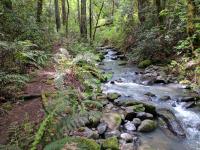
At times Redwood Trail gets really close to the creek.
There are about 10 miles of trails available in the park with several out and backs and loops possible. Generally, the park and its trails originate near Highway 29 and head uphill from that point into the canyon carved by Ritchey Creek.
The History Trail out and back is 1.1 miles in length one way and passes by not only the pioneer cemetery near the parking area but also leads to the Bale Grist Mill mentioned earlier. The trail parallels Highway 29 but moves far enough away to avoid much of the road noise. In some respects the trail here is more difficult than some of the others leading deeper into the park along Ritchey Creek. A little bit of elevation gain and some rocky surface adds some difficulty to an otherwise easy trail. The trail leaves the Ritchey Creek watershed, ascends the ridge that separates it from the Mill Creek watershed and descends down to Mill Creek to the mill.
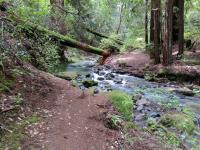
The trail continues on the other side of Ritchey Creek, but some slick rocks and unsteady footing made us decide to turnaround here instead.
The pioneer cemetery is a small parcel of land just off the trail with some of the graves enclosed in a white picket fence. Tucker and Kellogg are some of the more common names to be found here. These settlers arrived soon after Bale and in some cases obtained part of Bale's land in lieu of payment for services rendered. Lawsuits related to land ownership eventually drove much of the family out of the valley.
The majority of the park essentially reaches back through the length of Ritchey Creek Canyon. Most of the trails follow along Ritchey Creek itself. Trails such as the Redwood Trail parallels the creek and provides ample views of small waterfalls along its length. The trail surface is more typically packed dirt than rocky and sometimes made softer still by Redwood Tree needles that have been shed by the giants.
Ritchey Creek is not a large stream, but when rains are heavy the stream's flow might be ample enough to make crossing difficult without getting your feet a little wet. There are few, if any, bridges that ford the stream other than that for the main road in the park paralleling the highway.